

Oct 23,2025
Squeeze tube packaging is typically comprised of cylindrically shaped plastic. The squeeze tube allows the product to be used in the desired quantity without distortion. One end is sealed, and the other is capped to dispense the desired amount of product. Squeeze tubes are often employed in the packing of viscous substances. They serve the personal care, home products, pharmaceutical, food, and lubricant industries, making the squeeze tube market appealing to packaging producers.
Plastic is the most commonly utilized material in the production of squeeze tubes. The varied qualities of plastics are combined to create different final product properties, such as barrier properties, low cost, and printing capacity. Squeeze tubes help pack tiny quantities of items. Thanks to squeeze tubes, manufacturers may now provide various amounts of products to end consumers.
Cosmetics are in high demand in today's market due to the increasing importance of beauty for both men and women. On the other hand, a specialist cosmetics maker must be able to make a positive impression on the buyer and ensure that they test the excellent product first. Furthermore, people are looking for more than just a superb cosmetic; they want it at a lower price and are environmentally mindful. Tube packaging for specialty cosmetics fulfills a variety of manufacturer needs.
Tube packing may be an inexpensive way to supply specialist cosmetics to customers. Due to technological advancements, this packaging solution is now more cost-effective. Labeling items to create personalized branding for even small quantities of cosmetics is relatively straightforward.
Manufacturers benefit from increased versatility with squeeze tube packaging. Tubes can be created to accommodate as little as 3 ml or as much as 270 ml of a specialty cosmetic. This implies that the company may provide small samples or smaller tubes of pricey specialist cosmetics to entice first-time customers while maintaining larger volume tubes of the same product. The tubes may have different heads, such as needlepoint tips or slanted needles. The tube's external appearance can also be altered to reflect the product and brand.
Metallic covers and printed and silk-screen labels in various colors guarantee that the specialty cosmetic stands out even on crowded counter shelves. Depending on the cosmetic being packed, manufacturers can incorporate a brush-tip applicator, a metal-tip applicator, or a single-use twist-top to ensure that customers can use the product quickly. The adaptability of tube packaging increases its value for both producers and customers.
Tube packaging is an environmentally friendly alternative that enables companies to incorporate it into their branding efforts. When employing tube packaging, precise amounts may be filled, and unused packaging material can be recycled and reused. Furthermore, as technology advances, the raw materials utilized in tube packaging have become more environmentally friendly.
Tube packaging is stable, ensuring that specialty cosmetics and their specific components stay steady throughout the product's shelf life.
The tube packaging makes it easy to transfer specialty cosmetics. Tubes are less bulky than earlier plastic jars and pumps, weigh less, and are less expensive to deliver to merchants.
Consumers prefer tube packaging because of its convenience. Initially used for culinary goods such as jams, jellies, and mayonnaise, cosmetics makers now employ squeezable tubes. Consumers appreciate the convenience of tube packaging, which offers a range of heads for dispensing cosmetics. Consumers can easily distribute the appropriate amount of cosmetics, reducing waste.
As the popularity of squeeze tubes grows, various types are becoming available, including plastic tubes, laminate tubes, extruded and injection-molded tubes, and metal tubes. Of course, you have many more options when determining which squeeze tube style is best for your product line.
To make better decisions for your product or items, you need to understand the real benefits of the various squeeze tube types.
Plastic squeeze tubes are ubiquitous, and for a good reason. Extruded plastic tubes are lightweight, non-breakable, long-lasting, and almost leak-proof. Plastic tubes are made from around six distinct types of materials. Each substance preserves the product contained within the tube, significantly extending the product's shelf life compared to conventional containers, such as jars or bottles. Furthermore, when you release a plastic squeeze tube, it returns to its original shape without distorting any printing or labeling on the outside of the tube.
Many of the goods you use daily come in plastic squeeze tubes, including hand creams, shampoos, cleaning products, face masks, tanning lotions, and other cosmetics and personal hygiene items. Plastic squeeze tubes are also frequently used in the culinary, pharmaceutical, domestic, and industrial professions.
When it comes to laminate squeeze tubes, think of toothpaste tubes, as laminate tubes were initially used for packaging toothpaste. However, due to their flexibility, durability, and low cost, laminate tubes are now utilized for a wide range of items, including artists' paints, medicinal ointments, hair care products, and even dental care products.
Laminated tubes are similar to plastic squeeze tubes, but they offer a few advantages. Laminate tubes comprise multiple layers of aluminum and plastic, creating a better barrier inside the tube and providing it with qualities similar to those of a metal squeeze tube. This provides the packed product with optimum oxygen protection, allowing the squeeze tube to be entirely flexible and resilient while maintaining its appealing exterior appearance throughout the product's use.
Metal squeeze tubes, also known as aluminum squeeze tubes, are constructed from multiple thin layers of 99.9% pure aluminum, resulting in an impermeable, airtight tube that provides excellent protection to its contents. The sealing end of aluminum tubes is lined with latex to prevent product leakage, and an inner lacquer protects your product from interacting with the aluminum. Metal tubes are seamless and ideal for keeping materials such as cosmetics, paints, adhesives, food, and medications fresh and uncontaminated for intermittent use.